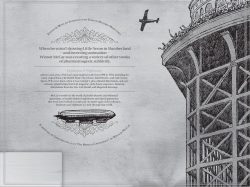

By Winsor McCay & various (Fantagraphics Books)
ISBN: 978-1-56097-569-4 (TPB/Digital editions)
Win’s Christmas Gift Recommendation: Picture Perfect… 10/10
Winsor McCay was a cartoonist and animator best known for Little Nemo in Slumberland. There was of course, so much more to him and this retrospective touches on the man whilst displaying a glorious abundance of his many graphic marvels.
Born in Spring Lake, Michigan, on 26th September, 1869 (or maybe 1871 in Canada: records differ) Zenas Winsor McCay was a brilliant and hugely successful cartoonist and animator who worked on newspaper illustrations, strips and political panels from 1898 until his untimely death in 1934.
This collection (a remastered release of a 1998 celebration) offers up some sublime examples of his many oeuvres. Following a Foreword by Gary Groth and context-packed biographical preface ‘The Dream Master’ by Richard Marschall, the man himself relates what we need to know in his own words thanks to 1927 essay ‘From Sketchbook to Animation by Winsor McCay’ and a 1926 letter to fellow artisan Clare Briggs (Danny Dreamer, Mr. and Mrs.) ‘On Being a Cartoonist’ before we begin a magical trawl through a magnificent career…
Spanning 1989 to 1903 – when McCay signed with The New York Herald publisher James Gordon Bennett – ‘Chapter One: Early Magazine Work’ offers political broadsides, early editorial diatribes in pictorial form, social commentary and pure illustration pieces, albeit gradually trending towards his later fascination with fantastic architecture and parlous prognostications of cultural collapse, before ‘Chapter Two: Newspaper Fantasy Illustrations’ focusses on wry speculative futurism – a popular topic of periodical publication back then…
Encompassing 1904-1924, ‘Chapter Three: Midsummer Daydreams and Other Comic Strips’ offers timeless examples of his ceaseless cartoon endeavours including A Pilgrim’s Progress, Poor Jake, Midsummer Daydreams/Daydreams, It Was Only a Dream, The Dreams of a Lobster Fiend, The Faithful Employee, He’s One of Those Telephone Lobster Fiends, And Then – Kerchoo! – He Sneezed!, Everyone Has Met That Well Known Character, Mr. Duck, and Rabid Reveries but sadly omits Jungle Imps, Dull Care, The Man from Montclair, Mr. Bosh, Hungry Henrietta and It’s Nice to be Married…
On October 15th 1905 the most important children’s strip in the world debuted in the Sunday Herald but Little Nemo in Slumberland had precursors and indeed a mature-reader rival. ‘Chapter Four: Dream of the Rarebit Fiend’ explores the many variations and iterations penned (and inked) from 1904 to 1913. Tireless McCay had conjured up visions for adult readers of The Evening Telegram, initially entitled Dream of the Rarebit Fiend. The editor, wishing to distance the feature from other strips, required McCay to use a pen-name, and he complied, signing the strips “Silas”, reputedly after a local garbage cart driver.
Where Nemo was a beautifully clean formal and surreal fantasy of childish imagination, Fiend displayed a creepy, subdued tension resonant with the fears and worries of its adult audience. Black, cruel and often outright sick humour pervades the series combining monstrous destruction and expressionist trauma. Even root causes of otherworldly nightmares were salutary. Each self-contained episode (18 reproduced here) and disturbing sequence of unsettling or terrifying, incredibly realistic images was the result of overindulgence; usually in late night toasted cheese treats!
Every anxiety from surreal terror to social embarrassment was grist for the fantasist’s mill and startling perspectives, bizarre transformations and uncanny scenes – always immaculately rendered – made the strip hugely successful and well-regarded strip in its day.
In 1906, American film pioneer Edwin S. Porter created a landmark 7-minute live action special-effects movie entitled The Dream of a Rarebit Fiend and the Edison company produced a cylinder recording with the same name the following year – played by the Edison Military Band. McCay himself produced four animated shorts in 1916-17: Dream of a Rarebit Fiend; Dreams of The Rarebit Fiend: The Pet, Dreams of The Rarebit Fiend: The Flying House and Dreams of The Rarebit Fiend: Bug Vaudeville, and despite his many other later successes returned to the feature sporadically over the years. Between 1923 – 1925 he revived it as Rarebit Reveries, officially attributing the strip to his son who signed the panels Robert Winsor McCay, Jr.
An artist hugely in-demand then and revered today, from 1903 to 1906 McCay invented many other all-ages cartoon works and ‘Chapter Five: Sunday Excursions’ highlights one of most enduring and inventive with 18 episodes of Little Sammy Sneeze, before the linear lunacy ends with his speculations on the world, its people and impending dystopias in ‘Chapter Six: Sermons on Paper’ with 54 stunning tableaux full-page rendered between 1913-1934, shaped by war and other disasters depicting so very many ways humanity could end and so few where we stop our species’ extinction event…
Although working far more than a century ago McCay still affects all aspects of graphic narrative produced ever since and his visions are more pertinent now than in his own lifetime. A darker side of an absolute master of our art form, this is work you must see and cannot miss.
Daydreams and Nightmares © 2005 Fantagraphics Books.
